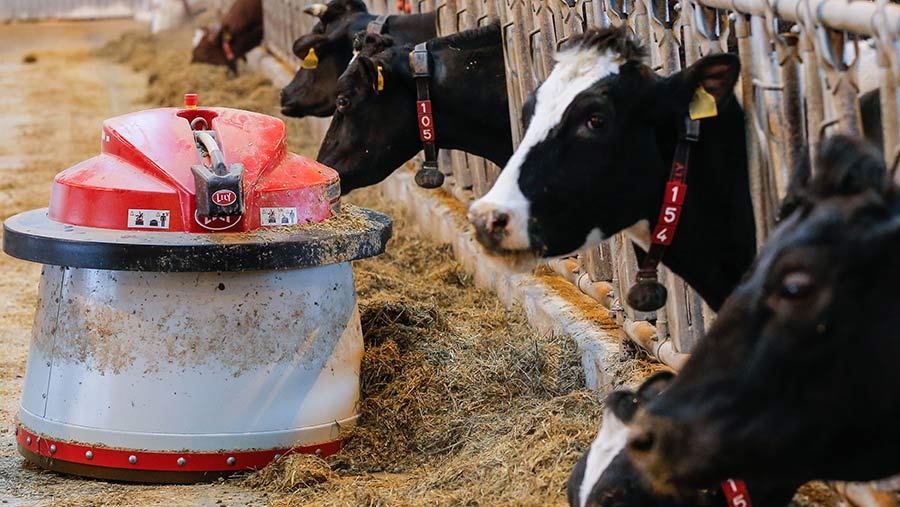How to decide if investing in dairy tech is worthwhile
 © Sergei Ilnitsky/EPA/Shutterstock
© Sergei Ilnitsky/EPA/Shutterstock The technology available to dairy farmers is developing fast and it can be difficult to decide where to invest your hard-earned cash.
To help decide which technology is really worth investing in, Ben Watts from Kite Consulting examines seven technologies; summarising their advantages and disadvantages, average cost and payback period.
See also: 5 new livestock gadgets for farming in 2020
Do the sums and look at the payback period
There are a number of objectives that any investment needs to provide to be considered. These include:
- Labour savings
- Input savings (improved efficiency)
- Time savings
- Productivity improvements (yield or quality)
A good benchmark for return on financial capital is a 10% return over and above depreciation.
Some technologies can be purchased outright, others leased, and many will have annual licences or specific running costs.
Therefore, it is best to calculate annual costs over the likely life of the asset so you can compare it directly against other systems on the market.
Remember the availability of grant funding is not a sound reason to invest in technology on its own.
Cow-side technology
Some of the best “cow-side” technology in terms of return on capital are those that determine oestrus. Combine these heat detection systems with health records and other parameters and they can lead to improvements in herd fertility and health, as well as lower vet costs.
- Cost: Base units £1,500-£3,000, plus collars or ear tags from £60-£100 each (some systems will attract grant funding)
- Benefits: Improved health, fertility, welfare, time saving
- ROI: Generally one to two years, so 50-100%
Automatic testing
This excellent, although expensive, technology has been available on robotic milking machines for a while, but it is now increasingly available on conventional milking parlours.
These systems use sophisticated herd management software to identify cows in need of, for example, progesterone testing for oestrus/PD and then intercept and test a milk sample for an appropriate period.
It can be extremely effective and will become cheaper over time.
- Cost: £35,000-£40,000 (some systems will attract grant funding)
- Benefits: Accuracy, time saving, improved efficiency, health, welfare, fertility, reduced vet and treatments
- ROI: Purported to be less than two years
Auto segregation
Not new but can be a great time-saving device for vet days and fertility routines.
You need to ensure the chosen system will link to your milking parlour and herd management software packages, if appropriate.
- Cost: £10,000-£15,000 dependant on system and herd size
- Benefit: Time saving
- ROI: Varies
Cluster flush and dip systems
This is proven technology and is becoming very common on new parlour installations.
Dip and flush systems will provide a time saving and insurance that every cow is dipped effectively.
- Cost: £700-£1,000 per parlour point (consider potential extra costs of dips/liners)
- Benefit: Time saving, quality/hygiene improvements, labour saving
- ROI: Varies
Robotic feed pushers
There are a number of robotic silage/feed pusher products on the market, which has had a positive impact on price competitiveness.
Look for a well-known system with comprehensive backup.
The benefits of regular feed push-ups include increased dry matter intake, yields, reduced sorting and improved rumen stability.
There will be some time savings, but a teleporter and push-up wheels can achieve similar results.
The real benefit comes at night, when cows still feed.
- Cost: £10,000-£15,000
- Benefit: Increased feed intake, productivity, time saving, lifestyle
- ROI: Varies
Robotic slurry scrapers
These are especially useful in robotic systems where cows do not leave sheds for routine scraping out.
Generally, they will have a limited range and run, so a full- or semi-slatted system is more favourable.
Some of the newer systems will vacuum the slurry.
- Cost: £10,000-£15,000
- Benefit: Increased feed intake, productivity, time saving, lifestyle
- ROI: Varies
Lighting
Research has shown that LEDs improve cow performance and responses, with optimal light levels (about 16 hours of light at 200 lux and eight hours of dark at about 40-60 lux), resulting in an 8% yield increase.
Costs vary greatly and more modestly priced systems can still meet target lux parameters and lighting spread requirements.
- Cost: £10,000-£30,000 (depending on building sizes)
- Benefit: Increased feed intake, productivity, fertility
- ROI: Depends on system costs – generally one to three years
